|
Bristle/Fireworms (Errantiate Polychaete) Identification
FAQs 9
Related FAQs: Polychaete ID 1, Polychaete ID 2, Polychaete ID 3, Polychaete ID 4, Bristleworm ID 5, Bristleworm ID 6, Bristleworm ID 7,
Bristleworm ID 8,
Bristleworm ID 10,
Bristleworm ID 11, &
FAQs: Worm Diversity
FAQs, FAQs
2, FAQs 3, & Worm IDs
1, Worm IDs
2, Worm IDs 3, Worm IDs 4, Worm
IDs 5, Worm IDs 6, Worm IDs 7, Worm
IDs 8, & Worm ID FAQs by Group/Phylum: Flatworm Identification ID, Nemertean, Proboscis, Ribbon Worm ID,
Nematode, Roundworm ID,
Nematomorpha,
Horsehair Worm ID, Acanthocephalans,
Thorny-headed Worm ID, Tubeworm ID, Hirudineans, Leech ID, Sipunculids, Peanut Worm ID, Echiuran Worm ID, & Bristle/Fireworms 1, Bristle/Fireworms 2, Bristle/Fireworms 3, Bristle/Fireworms 4, Worm
Identification, Polychaete Behavior, Polychaete Compatibility, Polychaete System, Polychaete Selection, Polychaete Feeding, Polychaete Disease, Polychaete Reproduction,
Related Articles: Worms,
Polychaetes, Flatworms/Planaria ,
|
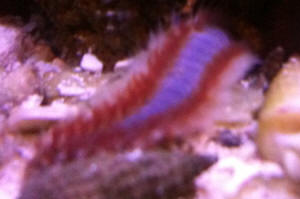
|
|
Constructive worm 4/7/2011
Hello!
<Hi there Carissa>
I have some kind of unusual worm that I can't find a similar
description anywhere! I've only seen its head once for a few
seconds just before turning off the lights as it appeared to be
grazing on some algae-- a kind of grasshopper like head with
short antennae. He seems sizable, the head was about 3/8 inch
wide. So he could be a Bristleworm,
<Very likely so>
but this worm seems to have a talent of moving small rocks and
attaching them to the rock he lives in (see attached picture--
his home rock is like a piece of Swiss cheese, so I can't
find him during the day). The white rocks on the left side were
brought up about 5 inches from the bottom of the aquarium just
last night, and as a reference for size, the one at the front is
about 3/4 inch long! They are very light weight aragonite, but
I'm still thinking, how big is this worm to bring up these
pieces of gravel?
<Good sized, strong>
Then the rocks are connected to the 'home rock' with
strands of silk-like substance (seen in the middle section just
under the red macro algae). And the pieces at the right are
attached and hanging from the rock. The rocks aren't in any
particular tube shape, either; just placed in-between the two
rocks.
<A good clue. Perhaps this is a Eunicid... see the Net
re>
I'm not too concerned about the worm harming anything else in
the tank.
I'm just wondering what it is and if it will grow into a
giant. I've had my tank for 2 months and the live rock with
the worm for about a month.
Specs: 26 gallon saltwater, canister filter, skimmer, 76 degrees,
ph 8.3, ammonia 0, nitrite 0, nitrate <5ppm, 2 green Chromis,
1 Firefish goby, frag of brown Zoas.
Thanks for any help!
Carissa
<Could be trouble for the Firefish if this worm is hungry. Bob
Fenner>
|
|
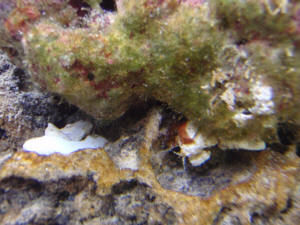 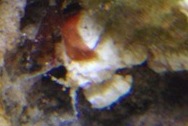 worm head? worm head?
|
Identify Worm: Eunicid --
3/11/11
Hello Fish Deeva (love the name, by the way), Lynn here today.>
Any idea what kind of worm this is? I did look. I am praying it's
not a giant reef worm.
<Nah, it's not a giant reef worm, it's an itty-bitty one! It
appears to be a small Eunicid (Polychaete in the family Eunicidae) of
some sort but most likely not the variety that gives hobbyists
nightmares (Eunice aphroditois). Eunicids such as yours tend to prey on
small pods and/or other worms/critters that stray a bit too close, but
thankfully don't pose much threat to larger livestock. They also
scavenge bits and pieces of food that land nearby. All in all they
comprise part of the beneficial biodiversity that makes for a healthy
system.>
If so, any idea on how to get him out?
<I'd leave it in place. Trying to grab one of these worms is
next to impossible since they're able to retract into the rockwork
at lightning speed. Trapping doesn't tend to work well either
because they apparently don't like leaving the relative safety of
their hole in the rock. I've seen individuals reach way out to
scavenge, but I've never seen one completely leave its
'den' in order to forage/hunt. The only other alternative as
far as removal is to take the rock out and either try to flush the area
with freshwater (which would kill everything on that part of the rock
(= potential ammonia spike), or try sealing the hole that the worm
retracts back into with a gel-type superglue used for gluing frags. The
problem with this last option is that many times, these worms have
multiple entrances/exits. If it were me, I'd just leave the little
fellow in place and enjoy watching him. For more information/list of
related FAQ's, please enter the term 'Eunice worm' in our
Google search engine: http://www.wetwebmedia.com/Googlesearch.htm
>
http://www.youtube.com/watch?v=2mWY69omYAw
<Neat video, thanks!>
Fish Deeva
<Take care, Lynn Z>
|
Worm ID: Syllid within Palythoa Colony --
3/9/11
Hey WWM Crew,
<Hey Todd, Lynn here today.>
I found this little critter on my Palythoas and was wondering if
you knew what this worm is?
<Yep, it's a type of Syllid, most likely in the genus
Myrianida, that's in a reproductive phase. Syllids are
generally fairly small worms (couple of cm/<1'), that tend
to live either in the upper layers of the sandbed or above it,
where they're associated with everything from sponges to
corals, tunicates, hydroids, bryozoans, etc. It's a very
diverse group of worms.>
I am not sure if it was eating my Palythoas, but it was for sure
irritating them.
<I bet so. The last time I ran across one of these guys, it
was associated with Palythoas and was indeed either consuming, or
at the very least irritating them. I would remove this, and any
others that appear within the colony. For more information,
please see the FAQ titled 'Saltwater Polychaete ID Question:
Syllid Stolonization -- 1/19/09' at the following link (as
well as link supplied within): http://www.wetwebmedia.com/PolychaeteIDF7.htm?h=
>
My best guess would be that it is in the Class: Polychaeta, but I
am not positive.
<Right you are. It's a Polychaete in the family
Syllidae.>
Any insight would be greatly appreciated.
Thanks,
<You're very welcome.>
Todd
<Take care, Lynn Z>
|
|
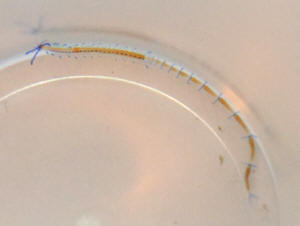 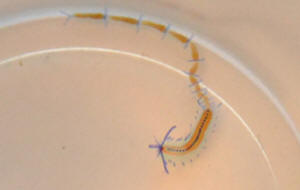
|
|
worm? 3/1/11
Hey guys! Might be a rhetorical question and if it is, I'm
sorry. I attached a picture of what I think is a spaghetti
worm...?? If so, I've read on your site that they're good
to have and I have maybe 1000 in my 46 gallon tank that is just
housing them along with seasoned live sand...... moved everything
else to a 150.
Thanks for the info ahead of time!
Tammy
<Does appear to be part of the cephalic end of a Terebellid.
Bob Fenner>
|
|
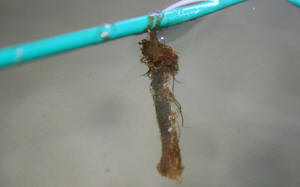
|
Strange worm? 2/13/11
Hello Bob and crew.
<Connie>
After feeding my reef tank tonight, I noticed a strange creature I am
hoping you can identify for me.
At first I thought it was a very fast, small red fish...but it seems to
be some sort of worm.
<?>
It is probably about 2 inches long. The 'head' of it is white
or light grey and the body is red. It is rather fuzzy, especially the
head area. It wriggles it's body to swim, and looks like a fish
swimming very fast all over the tank.
It has what actually look like fish eyeballs, and darts to the surface
to grab food. It knows exactly what it is doing -- darting to the
surface to grab food, then swimming to more food or to shelter, then
back to grab more food.
My Randolph's <?> Damsel seems to be a bit afraid of it.
Any idea what it could be or most importantly if it could be
harmful?
< Who knows?>
I couldn't possibly get a photo of it due to it's speed -- it
actually hurt my eyes to follow it darting around the tank.
The tank is 55 gallons, around 65 lbs live rock, all parameters are in
'normal' range.
Thank you!
<Likely an epitoke... See the Net re Errantiate Polychaetes. Bob
Fenner>
Strange worm? Email 2 2/13/11
Hello again. I think I was finally able to find out what the worm in
question is. It appears to be an Epitoke?
<Oh, likely so>
The lights are out on the tank right now and I can still see it
swimming around like crazy under the moonlight.
Almost the craziest thing I've ever seen in my tank -- the craziest
being the corpse of what I think was some sort of yellow Blenny
swirling around in the filter currant, which I had never seen before
and must have been living in there unnoticed for a good couple
years....
<Mmm, no; not as an epitoke>
he sure was a cute little fish and I was so sad he was dead...I
actually thought he was a large leaf swirling around in there until I
saw eyeballs.
Hopefully I was able to identify this Epitoke creature correctly, since
they are apparently harmless.
Thank you Bob and crew....for all the personal help and the great
website.
<... welcome! B>
|
Nudibranch? -- 02/04/11
Hey guys! As always, you guys rock!
<And roll!>
I need some help identifying a Nudibranch/worm/slug... I've
never seen this one before. Any ideas?
<Looks to be an Aphroditid: http://en.wikipedia.org/wiki/Sea_mouse>
Thanks-a-million!
--
John Patten
Tampa Reef Marine Management Services, LLC
<Welcome! Bob Fenner>
|
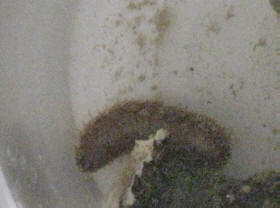 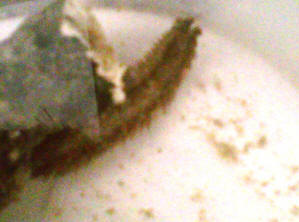 |
Re: Nudibranch? --
02/04/11
Should I discard it? I found it in a Nano reef.
Thanks again!
<... depends on what you have, what you're trying to do w/
"it"... See the Net re the life habits of this Errantiate
Polychaete family. B><<Don't tell John... but mainly
this family consumes other worms... Nereids principally,
Shhhh>> |
|
Mysterious Worm: Cirratulid/Hair Worm --
1/15/11
Hey WWM Crew,
<Hey there, Lynn here today.>
I am currently stationed overseas in Japan and decided to start a
saltwater aquarium
<Neat!>
...and recently I found this mysterious worm in my 30 gallon
tank. I noticed it when I was cleaning out some of the sand
because I noticed a red algae growing under the sand along the
glass.
<Sounds like BGA/Blue Green Algae/Cyanobacteria. Please see
the following link (as well as related links at the top of the
page) for more information: http://www.wetwebmedia.com/bluegralgae.htm
>
When I went to pick up my live rock I noticed two reddish thready
balls hanging onto the bottom of it. I set my live rock in
quarantine and noticed that the balls were moving. After about 5
minutes one unraveled to reveal a 3-4 in thread like worm. This
worm seems not to have a solid body but tiny threads and
tentacles. I have done some research but still can't find
anything on them. Can you help?
<Yep, no worries; you appear to have several harmless
Cirratulids (aka 'Hair Worms'). Most are 2" or less
in body length but the various appendages (two long feeding
tentacles and a number of filament-like gills can add to the
appearance of overall length. Please see the FAQ titled 'Red
Stringy Creature: Likely Cirratulid -- 10/14/09 at the following
link for more information: http://www.wetwebmedia.com/nonvertIDF49.htm?h=
>
Thank you
<You're very welcome. Take care, Lynn
Z><<Ahhh!>>
|
|
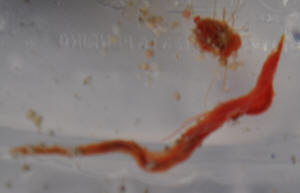
|
|
Sand tentacles.. 11/4/10
Hi!,
<Hi Gregory>
Thanks so much for all your help. WWM is amazing and I enjoy
reading your responses.
<Thank you>
I was hoping for some identification help. I have had a 90 gallon
aquarium up and running for several years. From time to time
later in the evening when my lights transition from MH to only
T5's and on into
night time, I will see clear almost transparent tentacles
emerging from the sand. I do have a DSB of 5" to 7", I
don't know why but I first thought Aiptasia, but I don't
think I'm on the right track (its seems to not like the
light).
<This is difficult to see, but could easily be Aiptasia, and
would be my guess>
Recently, I was able to get a photo of one that is next to the
glass (attached). I hope you can see the distance the tentacles
are extending. Sometimes the base or trunk extends higher than
the turbo shell in the background.
Thanks again!!
<No problem>
Greg C.
<Simon>
|
|
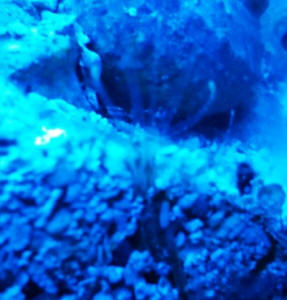
|
|
Re: Sand tentacles.. worm
11/10/10
Hey crew!
<Hey Gregory, sorry it has taken a few days. Am snowed under
at the moment and will be out for a while>
Leave it up to the wife, she found out what my the sand tentacles
were.
They are Polychaete worms.
<Really? Did not look like it to me, but ok>
Terebellid is what she is saying, but uuhhh after confirming what
she found out, I found a perfect example at http://www.wetwebmedia.com/WormIDF15.htm
titled "**Identification Weird tentacle sand worm" Are
these guys anything to worry about?
<Nah. Are beneficial life forms, contributing to the plankton
in your system, and the clear-up of detritus>
I seem to have quite a bit of them.
<Will 'wax and wane' with your system, feeding
patterns, maintenance etc.>
Thanks again for all your help....
<No problem, Simon>
|
|
Worm ID 11/07/10
Hi WWM,
<Hello Mike>
Recently I have found an infestation of these worms in my tanks.
I have seen some in my reef, and many more in my refugium. They
appear to be bristle worms to me, which as I understand are not
dangerous for my reef, but I would like to be sure that this
isn't anything worse. Any idea what this critter is?
<A Polychaete of some sort; looks like a Terebellid to me. Bob
Fenner>
Thanks, M
|
|
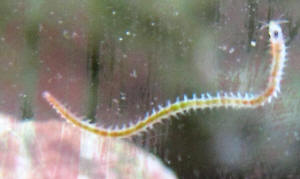
|
|
Bristle Worm/Friend Or Foe 8/2/10
Hey there crew.
<Jordan>
Just a quick question if you don't mind. I'm assuming
that what I have caught is a member of the Bristle Worm family.
So my question is simply since I was lucky enough to see him at
night and luckier still to catch him; Should he stay or should he
go now! (singing). I know from what I have read on the sight that
they are mostly harmless at this size but is it worth putting
back in. Will it eat my pods, or eat snails when he grows and I
can't find him again?
<Generally safe and good detritus eaters. More info found
here.
http://www.wetwebmedia.com/polychaetes.htm>
Thanks as always
<You're welcome. James (Salty Dog)>
Jordan B.
|
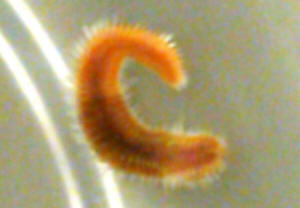 |
|
Bristleworm/ Bobbit worm ?
6/3/10
Hello WWM Crew!
Thank you so much for making this fantastic website. I have
relied on it for years!
Today I was surprised to look over and see this guy creeping out
of a crack in a rock.
<Duh dunt, duh dunt...>
I have been all over WWM and seen a few examples of something
like this.
#1 - http://www.wetwebmedia.com/polychaeidfaq3.htm
1st ID on the page looks similar, referred to as a
Bristleworm
<Is definitely a Bristleworm>
#2 - http://www.wetwebmedia.com/polychaeidfaq5.htm
2nd photo on the page, which is a Eunice spp looks a lot like
it
<And very likely a Eunicid, a member of this family... though
I don't think Eunice aphroditois... "the" Bobbit
worm>
I am trying to figure out if it is a threat that should be
removed.
<Mmm, if it's bugging (worming?) you, or obviously
attacking your livestock, yes>
I would love your opinion on it (and the best way to do it!)
<Bait it out remove it is so; enjoy it and show it off if
not>
It has a very small diameter, 2-3mm (there is a pompom crab in
the foreground to give you some idea)
<Yes>
but has easily stretched 3-4 inches from the crack/hole it seems
to come from with no end in sight! It seems to
have eyes (It retreats very quickly when I move towards the
tank)
<Oh yes; it does>
It's movement is similar to that of a tubeworm (the way it
extends and retracts). I think the photos give you a pretty good
idea but not perfect. It definitely has a face, a mouth, eyes
etc.
<Agreed>
Other information that might be useful is that I recently
completely redid my aquarium. I added some new rocks and corals
about a month ago so something could have come in on them. 3
weeks after the change in the tank, one by one, I lost the 3
small fish in there. They got a small amount of Ick which I
attributed to the stress of the change immediately after changing
the aquarium around, but it seemed as though their immune systems
were dealing with it and that they were improving.
<A good explanation>
I attributed the loss of the first fish (tail spot blenny) to
this stress as he wasn't quite right after the change; his
carcass was partially eaten but it could have been a crab that
did that. But the second fish (green bar goby) was not sick at
the time of his death and had no head when I found him. The last
fish was a small flasher wrasse and had what looked like a
bite/tissue damage on him when I found him dead but had not
showed signs of illness the previous day. All fish found dead in
the morning when the lights came on and were swimming around ok
the night before (before the lights went off).
When I found the fish like this I was concerned there might be
some kind of predator in the tank as I had all of these fish for
1-2 years with no problems and they all went dead within 1.5
weeks (beginning 2.5 - 3 weeks after changing the tank around). I
had dismissed my concerns about a predator until today because I
thought maybe the fish had died due to stress related illness and
maybe the Mithrax crab had eaten some of them (explaining the
damage to the carcasses).
<A most likely scenario>
Does it seem possible for a worm this small to inflict that kind
of damage on small fish?
<Is possible>
If it is not possible I am content to leave him in there as he is
very interesting. Do you think it is a Bobbit worm?
<Another member of the family Eunicidae>
Do you think I should remove it? If so, what is the best method
you recommend?
<Please read here re: http://wetwebmedia.com/polychaecompfaqs.htm
He seems so fast and I am not sure if the usual Bristleworm trap
methods work on those guys, so they leave their holes?
<Oh yes... at night>
Thank you very much for your time and all you do for the aquarium
hobby!
Deirdre
<And you for sharing. Bob Fenner>
|
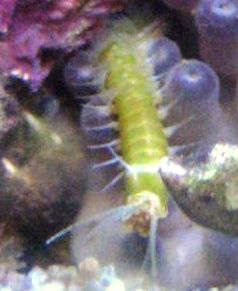 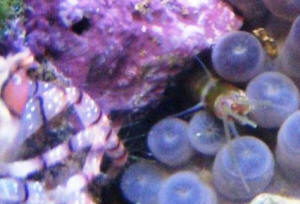 |
Polychaete ID
5/15/10
Hi. I'm trying to identify a particular type of Bristleworm, so
I'm hoping you can help me.
<Mmm, I "did a couple of years" ID'ing benthic
Sedentariate Polychaetes for some studies at USD... there are thousands
of species... need careful examination of the heads, podial
elements...>
I've searched online and found differing opinions on what this may
be. They are up to about 1-1/2 inches long, with long, narrow,
segmented bodies. The "head" is very small, slightly narrower
than the body, comes almost to a point, and is mostly a reddish-orange
color. The "body" section is an off-white color. The
"tail" end is a dark color, almost black. They live in my
coral substrate and don't seem to really bother anything. I've
seen my snails crawl right through a group of these worms with no
apparent problems, and my Ophiolepsis sea star and micro stars have been
living happily among them, too. I think they're neat because when
they're startled
(like when the lights come on), they turn an iridescent, translucent
blue color as they press themselves up against the glass and into tiny
crevices. Any ideas? I was thinking possibly Eurythoe complanata, but
I've seen varying reports of what that species is supposed to look
like. Thanks for your help!
Bryan
<Uhh... read here: http://wetwebmedia.com/polychaeidfaq2.htm
and the linked files above. Bob Fenner>
Re: Polychaete ID -
5/22/10
Bob,
<Bry>
Thanks for your efforts, but I'm probably not describing them very
well. I would say that they can be best described as a long, narrow
body consisting of a red section, a white section, and a black section.
Looks kind of like 3 different color worms were lined up head-to-tail.
With white podia all along. Most are only about 1/2" long, but
some can grow up to almost 2".
Anyway, thanks for the help.
Bryan
<REALLY need some good, well-resolved close-up pix...
B>
|
Blue worm, "You put the moon in my eyes..."
3/9/10
Can you tell me what this is?
<Oh yeah... Please see here:
http://wetwebmedia.com/polychaetes.htm
Looks like a common Hermodice sp.>
He is 12 inches long
<Yikes!>
and I can't find
one like him on line. His blue strip is very blue. Will he kill
my fish or my bottom living things, i.e., crabs, star fish,
snails etc?
<Might, yes>
I have looked everywhere on line and can't find another one
that is red and blue. Thank you.
Marti Liska
<Welcome! Bob Fenner>
Blue and red bristle worm 3/9/10
Hi:
<Yes Marti; same resp. as last>
I just bought a home with an established 14 year old 150 gallon
salt water aquarium in it. I am learning fast. However, a few
days ago I saw a ~10 inch long worm. I have established that it
is a bristle worm from my reading however, I have yet to see a
picture of one like this one. It is red on the outer edges and
has a sky blue strip down the center of the worm.
Now, I purchased 4 little gobies and they died. Next, my clown
fish was obviously getting sicker by the hour and died. Then
another fish that had been in the aquarium for years died. The
worm somehow got the dead fish in its "cavern" and
pulled it under the rock and I believe ate it. I called my
"fish man" who takes care of my system and he came
right over and said that my nitrates were "off the
chart." He did a 40 gallon water change and is going to do
one every other day until we are all systems go again so I can
get my new fish I have ordered from him. My two very large tangs
are fine, so are my star fish and other things like snails and
crabs (although I found one dead and out of his shell). I
don't know what to think about that.
After the first water change all the fish started doing much
better. But, this worm!!!! What on earth is this thing? Why have
I never seen another one on line with a sky blue strip down the
center? And most importantly, will he hurt my fish? He lives in
the same cavern in the rock that my big blue tang and
"his" cleaner shrimp live in and they don't seem to
be bothered by him. He does spend a lot of his time under the
rock but with a flash light I can see him in the back of the
cavern at times and once he was out late at night. Why can't
I find one on line with a blue strip and red edges? I do have
pictures of him but they are not down loaded yet.
Please let me know if he will kill any of my fish or other living
things. He is so
scary looking. I will email you a picture from my IPhone if that
will help.
Thank you in advance,
Marti Liska
<Welcome! BobF>
|
 |
|
|

